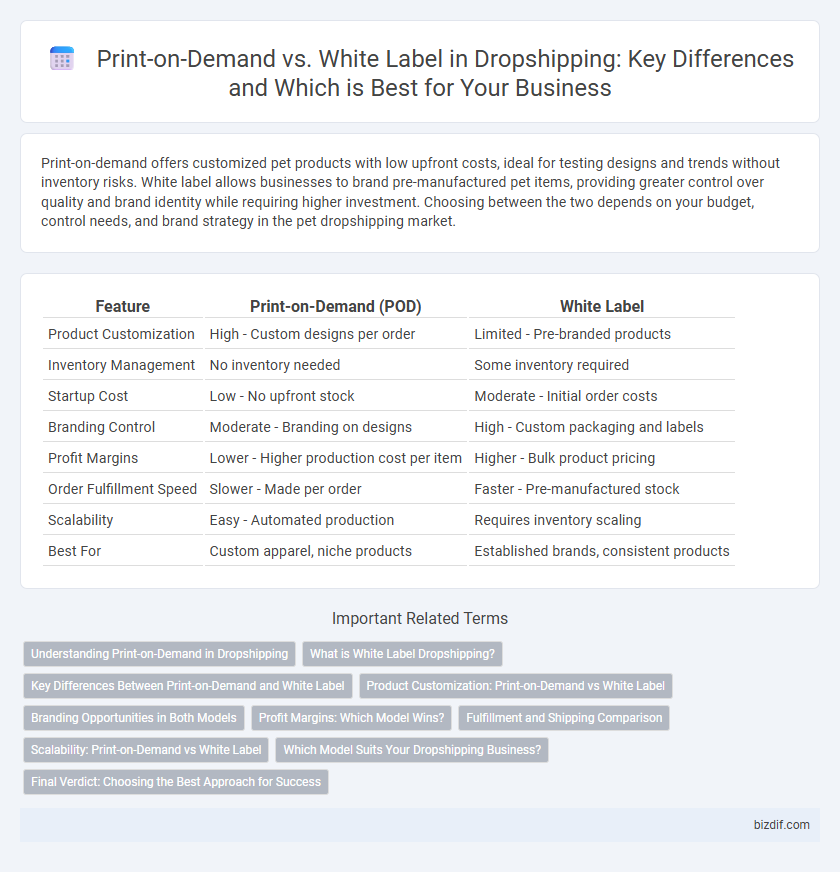Print-on-demand offers customized pet products with low upfront costs, ideal for testing designs and trends without inventory risks. White label allows businesses to brand pre-manufactured pet items, providing greater control over quality and brand identity while requiring higher investment. Choosing between the two depends on your budget, control needs, and brand strategy in the pet dropshipping market.
Table of Comparison
| Feature | Print-on-Demand (POD) | White Label |
|---|---|---|
| Product Customization | High - Custom designs per order | Limited - Pre-branded products |
| Inventory Management | No inventory needed | Some inventory required |
| Startup Cost | Low - No upfront stock | Moderate - Initial order costs |
| Branding Control | Moderate - Branding on designs | High - Custom packaging and labels |
| Profit Margins | Lower - Higher production cost per item | Higher - Bulk product pricing |
| Order Fulfillment Speed | Slower - Made per order | Faster - Pre-manufactured stock |
| Scalability | Easy - Automated production | Requires inventory scaling |
| Best For | Custom apparel, niche products | Established brands, consistent products |
Understanding Print-on-Demand in Dropshipping
Print-on-demand in dropshipping enables entrepreneurs to sell customized products without holding inventory, as items are printed and shipped only after a customer places an order. This model minimizes upfront costs and reduces risk compared to white label dropshipping, where products are branded but manufactured and stocked in advance. Understanding print-on-demand's integration with automated e-commerce platforms is crucial for seamless order fulfillment and efficient scaling.
What is White Label Dropshipping?
White label dropshipping involves selling products manufactured by a third party under your own brand name, allowing complete customization of packaging and branding. This model enables entrepreneurs to create a unique brand identity without handling inventory or production, as suppliers fulfill orders directly to customers. Compared to print-on-demand, white label dropshipping often supports a broader range of products beyond customizable prints, including electronics, skincare, and accessories.
Key Differences Between Print-on-Demand and White Label
Print-on-Demand (POD) offers customization with no inventory risk by producing items only after an order is placed, whereas White Label involves purchasing pre-manufactured products that are rebranded for resale. POD allows for more unique, personalized designs, and minimal upfront investment, while White Label requires larger bulk orders, providing greater control over product quality and branding. Key differences include production timing, inventory management, customization level, and initial capital requirements.
Product Customization: Print-on-Demand vs White Label
Print-on-Demand offers high product customization by allowing unique designs on individual items without inventory risk, ideal for personalized or limited-edition products. White Label provides customization through branding and packaging of pre-manufactured products, enabling a consistent product line with private brand identity. Both methods support customization but differ in production flexibility and brand control, crucial for strategic dropshipping decisions.
Branding Opportunities in Both Models
Print-on-demand allows entrepreneurs to build unique branding by customizing products with exclusive designs, enabling direct interaction with customers through personalized offerings. White label products offer scalable branding opportunities by allowing businesses to rebrand pre-manufactured items, maintaining consistent quality while focusing on marketing and customer loyalty. Both models support brand differentiation, but print-on-demand excels in creative control, whereas white label emphasizes streamlined product development.
Profit Margins: Which Model Wins?
Print-on-Demand offers lower upfront costs and minimal inventory risk but typically yields profit margins between 20-30%, while White Label requires higher initial investment but can achieve margins of 40-60% due to brand control and bulk production savings. Profit margins in Print-on-Demand are constrained by per-item customization costs, whereas White Label benefits from economies of scale and brand premium pricing. Entrepreneurs seeking higher long-term profitability usually favor White Label despite the greater upfront commitment.
Fulfillment and Shipping Comparison
Print-on-Demand (POD) fulfillment automates production and shipping only after an order is placed, minimizing inventory risk with variable production times, typically ranging from 2 to 7 days. White Label fulfillment often involves bulk inventory storage and faster shipping options through pre-manufactured products, allowing quicker delivery within 1 to 3 days but requiring upfront inventory investment. POD suits low-risk, on-demand customization, while White Label excels in consistent branding and speed for higher-volume sales.
Scalability: Print-on-Demand vs White Label
Print-on-demand offers scalability through automated production and low upfront costs, allowing businesses to quickly expand product variety without inventory risks. White label requires higher initial investment and inventory management, which can limit rapid scaling but enables greater control over branding and product quality. For scalable growth, print-on-demand suits flexible, low-risk expansion, whereas white label supports scaling with consistent product standards and higher profit margins.
Which Model Suits Your Dropshipping Business?
Print-on-Demand (POD) offers low upfront costs and customization flexibility, making it ideal for entrepreneurs targeting niche markets with unique designs. White Label requires more investment but provides greater control over branding and product quality, suitable for scaling businesses focused on long-term brand building. Choosing the right model depends on your budget, desired level of customization, and strategic goals for brand identity in the dropshipping market.
Final Verdict: Choosing the Best Approach for Success
Print-on-Demand offers low upfront costs and flexibility, making it ideal for testing new designs with minimal risk, while White Label provides greater control over branding and product quality, enhancing long-term customer loyalty. Success depends on your business goals; prioritize Print-on-Demand for rapid scaling and product variety, or White Label for establishing a unique brand identity and consistent product standards. Evaluate factors like startup budget, desired brand positioning, and customer experience to choose the best dropshipping model.
Print-on-Demand vs White Label Infographic

 bizdif.com
bizdif.com